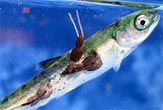
Wild salmon migrating downstream toward the sea are being killed en route by sea lice from salmon fish farms, a new study finds.
The fatalities range from 9 percent in the early spring, when lice populations are low, to 95 percent in late spring, when the parasites form massive clouds that young salmon have to swim through, the researchers say.
"We often worry about wildlife making humans sick, but here is a case where humans are making wildlife sick," said study team member Mark Lewis of the University of Alberta in Canada.
After latching onto their salmon hosts, the lice dig into the flesh, creating puncture wounds and open lesions that make the young fish more vulnerable to predators and infection from viruses and bacteria.
The researchers studied chum and pink salmon, which, unlike most other salmon species, begin their seaward trek shortly after hatching. Due to their large mass--up to 40 pounds--and protective body scales, adult salmon are better protected against the lice and can carry the parasite without becoming sick. Juvenile salmon, meanwhile, are about an inch long, weigh only about half a gram and are still without armor.
"All it takes is one or two lice to kill one of these juvenile fishes," said study leader Martin Krkosek, also of the University of Alberta. "The lice can literally feed on the fish faster than it can feed itself and the fish starves to death."
By situating along natural salmon migration routes, aquafarms are interfering with the natural life cycles of the wild salmon, Krkosek said. Normally, adult salmons are far offshore when the juveniles are migrating to sea, and the two groups don't meet for several months.
Sign up for the Live Science daily newsletter now
Get the world’s most fascinating discoveries delivered straight to your inbox.
"That's when the parasites get transferred from generation to generation," Krkosek told LiveScience. "But at that point, the juveniles are much larger and have scales."
The finding is detailed in the Oct. 2 issue of the journal for the Proceedings of the National Academy of Sciences.
- Mystery of the Missing Salmon
- Sneaky Parasite Filmed While Infecting Blood Cells
- Oops! Scientists Nudge Fish Closer to Extinction
- Salmon of Small Stature Endowed with Mating Advantage
- Study: Cat Parasite Affects Human Culture












